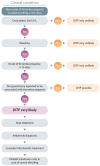Treatment of drug-induced immune thrombocytopenias
- PMID: 35642486
- PMCID: PMC9152960
- DOI: 10.3324/haematol.2021.279484
Treatment of drug-induced immune thrombocytopenias
Abstract
Several therapeutic agents can cause thrombocytopenia by either immune-mediated or non-immune-mediated mechanisms. Non-immune-mediated thrombocytopenia is due to direct toxicity of drug molecules to platelets or megakaryocytes. Immune-mediated thrombocytopenia, on the other hand, involves the formation of antibodies that react to platelet-specific glycoprotein complexes, as in classic drug-induced immune thrombocytopenia (DITP), or to platelet factor 4, as in heparin-induced thrombocytopenia (HIT) and vaccine-induced immune thrombotic thrombocytopenia (VITT). Clinical signs include a rapid drop in platelet count, bleeding or thrombosis. Since the patient's condition can deteriorate rapidly, prompt diagnosis and management are critical. However, the necessary diagnostic tests are only available in specialized laboratories. Therefore, the most demanding step in treatment is to identify the agent responsible for thrombocytopenia, which often proves difficult because many patients are taking multiple medications and have comorbidities that can themselves also cause thrombocytopenia. While DITP is commonly associated with an increased risk of bleeding, HIT and VITT have a high mortality rate due to the high incidence of thromboembolic complications. A structured approach to drug-associated thrombocytopenia/thrombosis can lead to successful treatment and a lower mortality rate. In addition to describing the treatment of DITP, HIT, VITT, and vaccine-associated immune thrombocytopenia, this review also provides the pathophysiological and clinical information necessary for correct patient management.
Figures




References
-
- Towhid ST, Tolios A, Munzer P, et al. . Stimulation of platelet apoptosis by balhimycin. Biochem Biophys Res Commun. 2013;435(2):323-326. - PubMed
-
- Curtis BR. Drug-induced immune thrombocytopenia: incidence, clinical features, laboratory testing, and pathogenic mechanisms. Immunohematology. 2014;30(2):55-65. - PubMed
-
- Gruel Y, De Maistre E, Pouplard C, et al. . Diagnosis and management of heparin-induced thrombocytopenia. Anaesth Crit Care Pain Med. 2020;39(2):291-310. - PubMed
Publication types
MeSH terms
Substances
LinkOut - more resources
Full Text Sources
Medical

